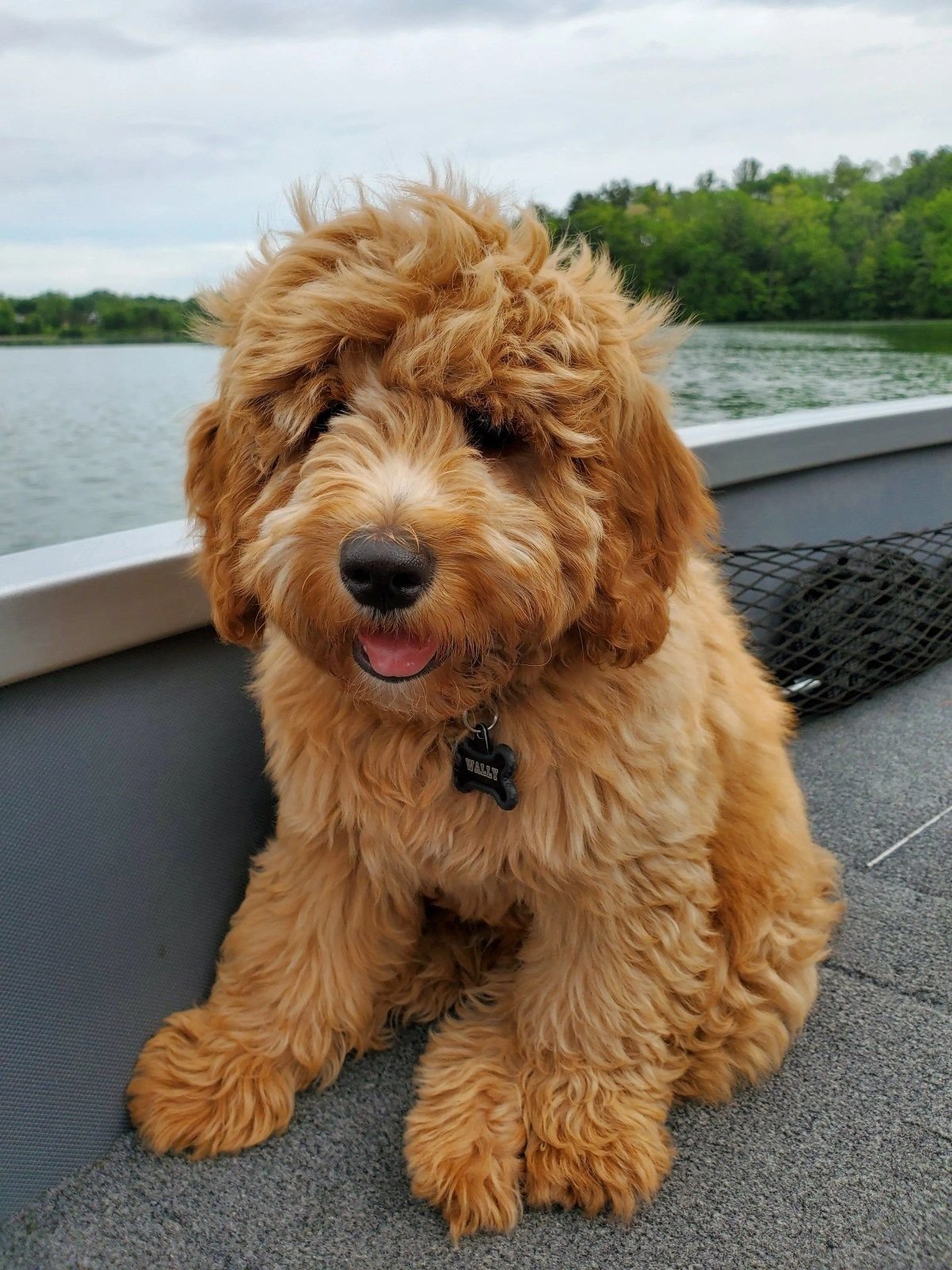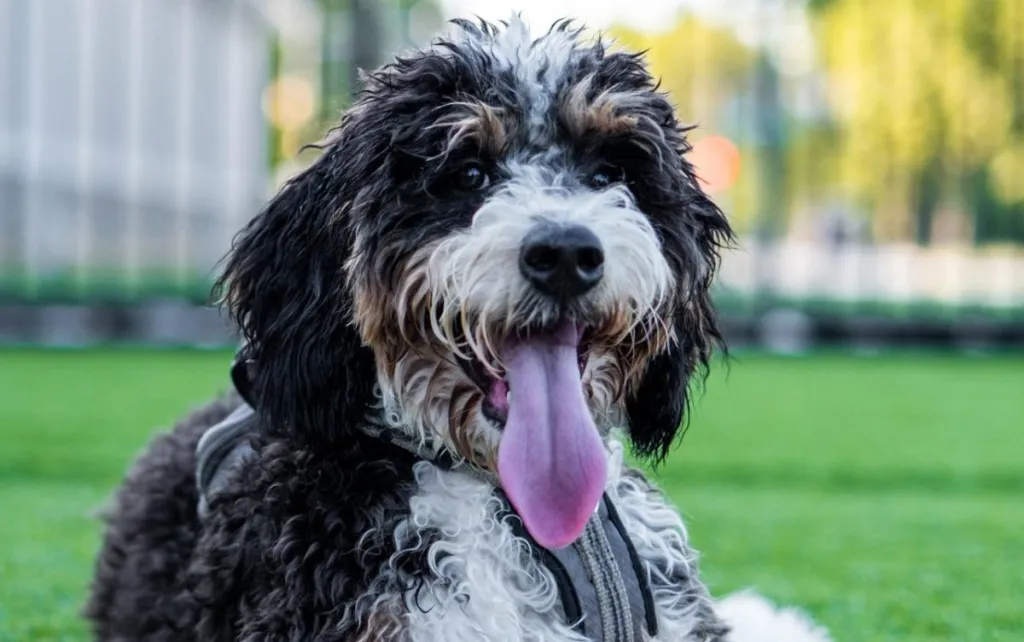Breeds
Mini Labradoodles
-
Overview
-
Temperament
-
Adaptability
-
Health
-
Owner Experience
-
Grooming
-
Activity Level
-
Size
-
Life Span
-
Did You Know?
The Miniature Labradoodle is a cross between a Labrador Retriever and a Miniature Poodle. Second-generation crosses could include a Labradoodle and a Mini Poodle or two Mini Labradoodles as parents.
This hybrid dog breed was originally developed to create smaller potential service dogs that might be a good fit for people with allergies to dog fur. With a mixed breed, you can end up with any combination of traits from the parent breeds. Often, Mini Labradoodles are smart, friendly, and sociable dogs that are highly trainable.
They are often found working as service dogs and therapy dogs and living as beloved family companions. Although they are not recognized by the AKC, the Mini Labradoodle is recognized by other canine registries. The American Canine Hybrid Club recognizes the Miniature Labradoodle.
Well-socialized Mini Labradoodles tend to get along well with children, other dogs, and other pets. Due to their smaller size, these dogs can be injured by accidental rough play or accidental falls, so any interactions between young kids and puppies should be closely supervised.
Miniature Labradoodles will usually bark to alert you when someone is at the door, but generally are not prone to nuisance barking unless they have been trained into it. It may not be a bad idea to train your dog to stop barking early on. Well-socialized Mini Labradoodles may be initially wary of strangers, but tend to warm up quickly and will often be happy to make a new friend.
Miniature Labradoodles are highly adaptable. Provided they get enough exercise, attention, and mental stimulation, they can adapt well to apartments as well as larger homes. They tend to do best in moderate climates, but can tolerate warmer or colder climates. As with any dog, they are sensitive to heat.
Although they tend to have a fluffier coat, they are also smaller and may need to bundle up in some winter dog products to stay warm while out on walks in the cold. Mini Labradoodles are also very much companion breeds. They bond closely with their families and thrive on being near them, so they do not like to be left alone for long periods of time.
Potential health concerns to be aware of in a Miniature Labradoodle can include elbow dysplasia, hip dysplasia, Addison’s disease, epilepsy, hypothyroidism, cataracts, and progressive retinal atrophy. The health of the parents and good breeding practices make a big difference in the health of Mini Labradoodle puppies.
Reputable breeders will screen their dogs to avoid passing preventable issues to puppies. Make sure you are asking the breeder about the health and genetic history of both parents. You can also ask about any health tests or clearances that have been done to help allay any concerns you may have.
Miniature Labradoodles tend to be highly intelligent and eager to please. This generally makes them easy to train and a good fit for owners of all experience levels. In fact, their parent breeds are considered some of the best dog breeds for first-time owners
You’ll also get some more opportunities for socialization early on. Ongoing training throughout your Mini Labradoodle’s life, like learning new tricks, can help provide additional mental stimulation.
Grooming requirements with a Mini Labradoodle can vary. On the Poodle side, you have a non-shedding, but high-maintenance, coat that needs daily brushing along with trimming and grooming every 6-8 weeks. On the Lab side, you have a higher-shedding coat that is more low-maintenance, requiring some weekly brushing or brushing a few times a week and intermittent bathing.
Overall, Mini Labradoodles range from having a non- to low-shedding coat. They can have one coat type or the other, or a combination of both of them. So, you will want to be prepared for brushing a coat a few times a week and the possibility of more grooming needs. Regardless of coat type, there are some other general grooming tasks you can count on.
Regular dental care for your dog will help prevent serious dental issues like gum disease and tooth decay later in life. Checking your dog’s ears regularly to ensure they are dry, clean, and free of debris, and carefully cleaning as needed, helps prevent ear infections. This is especially important for dog breeds with floppy ears as they are more prone to developing ear infections.
Miniature Labradoodles can be high-energy dogs. In general, they require daily walks plus some playtime and extra activity to be happy and healthy. Since they love to be around their family and can have an exuberant and outgoing personality, they will likely be up for more playtime if you are.
Because of your Mini Labradoodle’s smaller size, you will want to keep an eye out for signs of overexertion. This little dog may get tired more easily at times and could push themselves too far in their excitement. On the other hand, they may just keep going and going with no signs of slowing down.
It’s up to you to figure out where your dog is most comfortable and then try to stay within that range. What is most important is making sure your Miniature Labradoodle gets enough exercise and mental stimulation. They don’t tend to like being alone for long periods of time and can become destructive and difficult to handle if they are bored or don’t get enough exercise.
Fully-grown Mini Labradoodles usually stand 14-16 inches tall and weigh 15-30 pounds.
Miniature Labradoodles generally live for 12-14 years on average.
The Oxford Dictionary officially recognized the word “Labradoodle” in 2006, which means you can use it in Scrabble.
Mini Goldendoodle
-
Overview
-
Temperament
-
Adaptability
-
Health
-
Owner Experience
-
Grooming
-
Activity Level
-
Size
-
Life Span
-
Did You Know?
The Mini Goldendoodle is a smaller version of the ACHC-recognized Goldendoodle. It is a cross between a Miniature Poodle and a Golden Retriever, a Miniature Poodle and a Goldendoodle, a Mini Goldendoodle and a Mini Poodle, or two Mini Goldendoodles.
The breed continues to see an increase in popularity as people love the low/non-shedding properties any breed mixed with a Poodle can possess. Although this breed is very popular, it is not currently recognized by the American Kennel Club.
With some of the friendliest and most affectionate dog breeds as parents, it’s no wonder that the Mini Goldendoodle tends to be a sweet, loving, intelligent, cheerful, and playful dog that bonds closely with their families.
As long as they are well-socialized, Miniature Goldendoodles tend to make excellent family companions. They tend to get along well with children, other dogs, and other pets. Although they will alert you of strangers at the door, they tend to warm up quickly as they are more interested in making friends and receiving attention.
Mini Goldendoodles are highly adaptable dogs. Their smaller size makes them a great fit for apartment living or for bigger homes with yards where they can run. As long as they get enough daily exercise, mental stimulation, and attention, they can adapt well.
These little dogs tend to do well in just about any climate. However, like any dog, they are sensitive to heat. Due to their smaller size, you may need to gear up with some dog-friendly winter gear when temperatures start falling.
Reputable breeders will screen their dogs to avoid passing preventable issues to puppies. Make sure you are asking about the health and genetic history of the parents. You can also ask about any health tests and clearances that have been done.
The Mini Goldendoodles is a highly intelligent dog that picks up on things quickly and is eager to please. They tend to be sensitive to tone of voice as well. As long as training is consistent and focused on positive praise and reward, a Mini Goldendoodle will strive to be obedient and impress you and tends to excel at almost any task.
Although a Mini Goldendoodle tends to inherit the low/non-shedding Poodle coat, they still need some regular grooming and maintenance to keep their coat healthy and looking great. Daily brushing is recommended to remove tangles and prevent mats. Bathing is occasional and can often be relegated to the dog groomer that is recommended you visit every 6-8 weeks.
In addition to coat care, you will also need to take care of your Miniature Goldendoodle’s nails, ears, and teeth. The groomer can help handle some of this during visits, but you will still need to do some maintenance at home between visits.
Although the parents of this breed have a lot of energy, a Mini Goldendoodle tends to sit in a more moderate activity range. Daily walks plus some playtime and time to run are usually enough for them. But, they are also likely to match their energy level to yours, so be prepared for some bursts of energy as well as plenty of cuddling on the couch.
Fully-grown Mini Goldendoodles usually stand 13-20 inches tall at the shoulder. A Miniature Goldendoodle puppy can vary in size based on the generation of the dog.
An F1, or 1st generation cross, would be 50% Miniature Poodle and 50% Golden Retriever. The result is generally a dog that will range from 30-40 pounds. When a Mini Goldendoodle is crossed with a Mini Poodle, the result is an F1-B or 2nd generation cross.
This hybrid dog breed would be smaller in size, around 15-30 pounds, and would be more likely to inherit the low/non-shedding coat properties based on the fact that it is 75% Poodle. Looking at the size of the parents for an F1 or F1-B puppy can be a good indication of what size to expect in a fully-grown Miniature Goldendoodle.
Mini Goldendoodles generally live for 10-15 years on average.
Miniature Goldendoodles are also sometimes referred to as Miniature Groodles or Mini Groodles.
Mini Bernedoodle
-
Overview
-
Temperament
-
Adaptability
-
Health
-
Owner Experience
-
Grooming
-
Activity Level
-
Size
-
Life Span
-
Did You Know?
A Mini Bernedoodle is a cross between a Bernese Mountain Dog and a Miniature Poodle (F1), a Mini Bernedoodle and a Mini Poodle (F1B), or two Mini Bernedoodles (F2). They tend to be affectionate and loving dogs that make great family pets. They are even known to make great therapy dogs!
Although they are not recognized by the American Kennel Club, they are recognized by other canine registries. The Designer Dogs Kennel Club, American Canine Hybrid Club, and more all recognize the Miniature Bernedoodle.
facts about Bernedoodles is that they are true companion dogs. They are cuddly companions that love nothing more than being with their favorite humans. As long as they are well-socialized and trained, Mini Bernedoodles tend to get along well with children, other dogs, other pets, and even strangers.
Miniature Bernedoodles are highly adaptable dogs. They do well in larger homes as well as apartments. They are sensitive to heat and extreme cold, but do well in most climates. Because they bond so closely with their families and thrive on attention, they do not like to be left alone for long periods of time and can develop separation anxiety if you do not work with them early on.
Potential health concerns to be aware of in Mini Bernedoodles can include hip dysplasia, elbow dysplasia, Addison’s Disease, and chronic adrenal insufficiency. Good breeding practices make a big difference in the health of puppies.
Mini Bernedoodles are intelligent dogs that pick up on things quickly and are eager to please. This makes them a highly trainable dog that is a good fit for owners of all experience levels.
Although their coat tends to be low-shedding and will range from straight to wavy or curly, the Mini Bernedoodle coat requires some maintenance. Daily brushing is recommended to remove tangles and prevent mats. Professional grooming is recommended every 6-8 weeks.
Although Mini Bernedoodles will be playful and have bursts of energy while playing, they are not high-energy dogs. They tend to sit in a more moderate range. Daily walks plus some playtime throughout the day are usually enough for them.
But, they love spending time with you and will likely be up for more activity if you are. They may be smaller dogs, but they also tend to be relatively athletic. When puppies finish growing, you can try higher-impact activities like running, hiking, training for dog sports, and more.
Fully-grown Mini Bernedoodles usually stand 12-22 inches tall. They can range from 30-50 pounds. F1B and F2 Mini Bernedoodles usually weigh 20-30 pounds and are on the shorter side of the range.
Mini Bernedoodles generally live for 12-15 years on average.
Although they are most commonly called Mini Bernedoodles, these dogs are also sometimes called Mini Bernadoodles, Mini Berniedoodles, Mini Bernese Mountain Poos, Mini Bernesepoos, Mini Bernepoos, Mini Bernesesdoodles, and Mini Bernese Poodles.
Cavapoo
-
Overview
-
Temperament
-
Adaptability
-
Health
-
Owner Experience
-
Grooming
-
Activity Level
-
Size
-
Life Span
-
Did You Know?
The Cavapoo is a cross between a Cavalier King Charles Spaniel and a Miniature Poodle or between two Cavapoos. This designer breed became popular in Australia during the late 1990s. It is still one of Australia’s most popular dog breeds and is also a popular breed in both the US and the UK.
Although it is not currently recognized by the American Kennel Club (AKC), it is recognized by other dog registries and clubs. The American Canine Hybrid Club (ACHC), Designer Dogs Kennel Club (DDKC), Designer Breed Registry (DBR), and more all recognize the Cavapoo.
Cavapoos tend to be outgoing, loving, and playful dogs. They make fantastic family companions as they tend to get along with children, other dogs, and other pets. Their sweet, gentle nature makes them a great companion breed. They also make great therapy dogs!
Due to their smaller size and moderate energy level, the Cavapoo is a highly adaptable dog that thrives in apartments as well as larger homes. They do tend to have short muzzles, which makes them even more sensitive to heat. They also do not handle the cold very well either and may need some winter dog products to stay warm while out on walks when temperatures drop.
Potential health concerns to be aware of can include Mitral Valve Disease, patellar luxation, progressive retinal atrophy, and hip dysplasia. Good breed practices make a big difference in the health of puppies.
Reputable breeders will screen their dogs to avoid passing issues to puppies. Make sure you ask about the health and genetic history of both parents. You can also ask about any health tests or clearances that have been done. Willingness and openness to talk about these things and their breeding practices are qualities to look for in a great breeder
A Cavapoo tends to be a highly trainable dog that is one of the best dog breeds for first-time owners. They are intelligent and eager to please. Although they are smart and learn quickly, they also have a mind of their own and may be more interested in cuddling or sitting on your lap than listening to basic commands.
They can usually be persuaded to change their mind and find the command or trick worth performing if there is a treat or praise involved. They do tend to get bored, so you’ll want to keep training sessions short and focused on fun. This is a good way to keep your dog engaged during training sessions
A Cavapoo’s coat can vary depending on the genes they inherit from the parent breeds, but they generally have a soft coat that is wavy or curly and is low/non-shedding due to the presence of the Poodle in the cross. Common coat colors are red, white, black, red and white, and tricolor.
A low/non-shedding coat does not mean low maintenance. Daily brushing is recommended to remove tangles and prevent mats. Professional grooming is recommended every 4-8 weeks. In addition to coat care, you will also need to take care of your Cavapoo’s nails, ears, and teeth.
The dog groomer may be able to take care of some of this, but you will still need to do some maintenance at home between visits. Nail trims once or twice monthly keep nails from growing too long. Ear checks weekly with careful cleanings as needed help prevent ear infections.
Cavapoos tend to have a low to moderate energy level, which can adapt to their owner’s lifestyle. Daily walks with some playtime are usually enough to keep this pup happy and healthy. They can be prone to weight gain if they are overfed and do not get enough exercise, so it’s important to ensure proper diet, nutrition, and activity to keep this pup healthy.
A Cavapoo loves spending time with their favorite humans and will be more than willing to be more active if their owner leads a more active lifestyle. Plus, they tend to love chasing balls and are almost always up for playing fetch
A fully-grown Cavapoo usually stands 9-14 inches tall and weighs 12-25 pounds. Looking at the size of the parents, especially the mother, can give you a better idea of what to expect when it comes to size for a particular Cavapoo puppy.
Cavapoos generally live for 10-15 years on average.
The Cavapoo is sometimes also called a Cavoodle or a Cavadoodle.




